| Logging Boat Types & Operation
Logging boats had one purpose, getting logs from the forest to the mill. They towed booms of logs downriver, then herded them into spillways and over dams. Russels made four main types of logging vessels, but mostly the Winch Boats and Warping Tugs:
Dozers or Sluicers
No winches, these extremely compact, maneuverable and powerful boats could almost spin in place with a power burst. 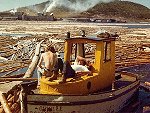
e.g. Orville |
Winch Boats
26-28 foot flat-bottomed steel tugs with front winches, could self-pull over land and self off-load from trucks. 
e.g. Ancaster |
Warping Tugs
35-40 foot larger flat-bottomed logging tugs, sometimes with a front mount pusher rake, able to pull themselves over land. 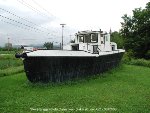
e.g. Siskin |
Larger Logging Boats
Not Alligators, these larger vessels were made for specialized purposes and environments.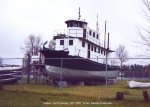
e.g. Hallett |
The mechanical advantage provided by the gears in the winch could exert much more torque than the propeller in the water. So much more, that the winch could actually pull steel boats up to 40 feet in length over land! Flat-bottomed "Alligator" wood-steel boats were produced by Russel Bros. in Fort Frances, but all-steel boats were far more durable, to withstand knocking about in a sea of logs.

WINCHING A LOG BOOM
The boat would leave the boom and run ahead of it between one-half mile and one mile, depending on the size of the boat and the length of the cable. It would then drop a large anchor over the bow, which was fastened to the forward mounted winch cable.
The boat would then turn 'round and run back to the boom of logs. They'd fasten a short length of cable between the tow post on the after deck and one of the short logging chains that connected the boom timbers. They would then engage the winch and wind in the forward cable, thereby moving, or warping, the boom of logs in the direction they wished to go at a speed of between one-half and one mile an hour, depending on the velocity of the wind.
While this may seem a very slow rate of speed, it was very efficient and an economical method of bringing large booms of logs to the mill and did the work of much larger and more costly steam boats. Consider this: A small winch boat like the Ancaster could move ONE MILLION feet of logs, and these boats had engines of only 20 or 30 horsepower!
When the boat had wound in all the cable, it would lift the anchor onto the deck and the procedure would be repeated until the logs were at the mill. Russel Brothers changed the name of the type of logging boat that they built from "headworm" or "alligator" to "winch boat" for one under 28 feet long, and "warping tug" for the ones over 35 feet in length.
VIDEO
Videos courtesy of the  1957 short entitled "Log Drive". 1957 short entitled "Log Drive".
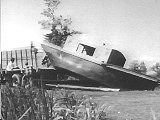 |
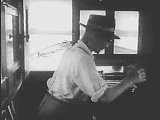 |
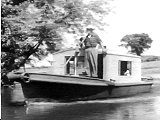 |
The Alligator pulls itself off the truck and overland
VIEW 1:15 |
Assembling and moving a large log boom
VIEW 3:28 |
Rounding up stray logs after the drive
VIEW 1:13 |
|
|
 |
Log Drive
This 1957 NFB film of the Québec log drive follows the logs from the winter forest, through rivers and rivers, over dams to the mill in Buckingham.
PLAY 30 min. MORE INFO |
|
Russel Winch Boat
1990 compilation shows working winch boats, and the dedication of the Esnagi at the National Museum of Science and Technology.
PLAY 16 min. MORE INFO |
 |
|
For more Russel exhibits visit Owen Sound Marine & Rail Museum 1165 1st Ave West, Owen Sound, ON N4K 4K8
(519) 371-3333  http://marinerail.com http://marinerail.com |